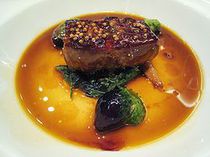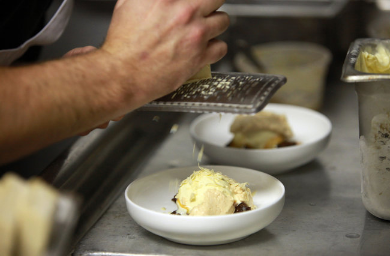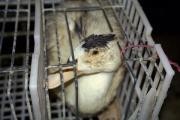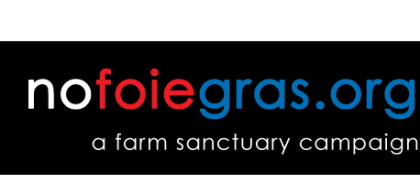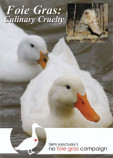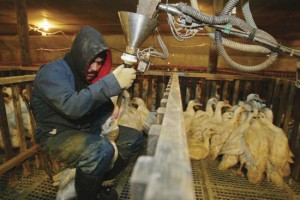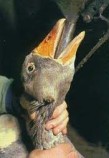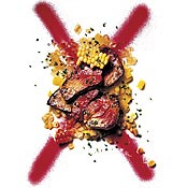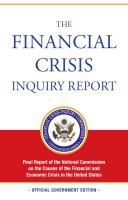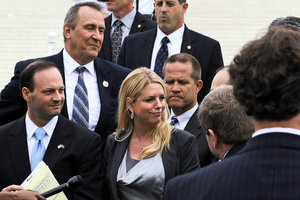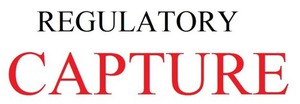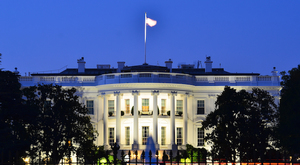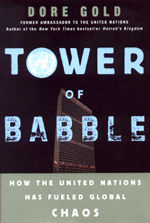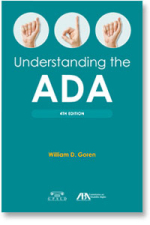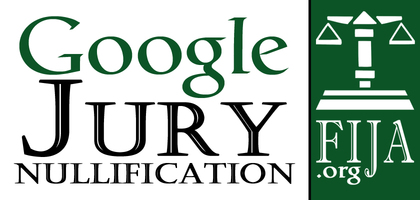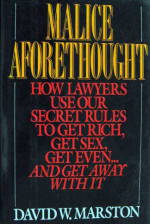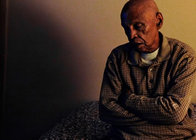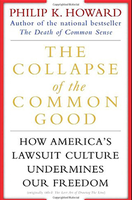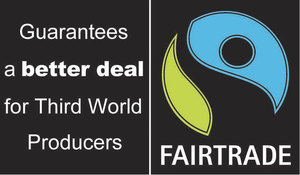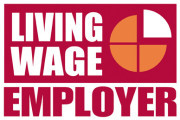Bid Adieu to Foie Gras
Foie Gras
Wikipedia
Foie gras, French for "fat liver") is a luxury food product made of the liver of a duck or goose that has been specially fattened. By French law,[1] foie gras is defined as the liver of a duck or goose fattened by force-feeding corn with a feeding tube, a process also known as gavage. In Spain[2] and other countries outside of France it is occasionally produced using natural feeding.[3] Ducks are force-fed twice a day for 12.5 days and geese three times a day for around 17 days. Ducks are typically slaughtered at 100 days and geese at 112 days.[4]
Foie gras is a popular and well-known delicacy in French cuisine. Its flavor is described as rich, buttery, and delicate, unlike that of an ordinary duck or goose liver. Foie gras is sold whole, or is prepared into mousse, parfait, or pâté, and may also be served as an accompaniment to another food item, such as steak. French law states that "Foie gras belongs to the protected cultural and gastronomical heritage of France."[5]
The technique of gavage dates as far back as 2500 BC, when the ancient Egyptians began keeping birds for food and deliberately fattened the birds through force-feeding.[6] Today, France is by far the largest producer and consumer of foie gras, though it is produced and consumed worldwide, particularly in other European nations, the United States, and China.[7]
Gavage-based foie gras production is controversial, due mainly to the animal welfare concerns about force-feeding, intensive housing and husbandry, and enlarging the liver to 10 times its usual volume. A number of countries and jurisdictions have laws against force-feeding, and the production, import or sale of foie gras; even where it is legal, a number of retailers decline to stock it.
In California, Going All Out to Bid Adieu to Foie Gras
In California, Going All Out to Bid Adieu to Foie Gras
The New York Times
by Adam Nagourney
October 15, 2011
LOS ANGELES — A line up of people streamed into an unmarked, dimly lighted storefront on Fairfax Avenue as night fell Friday, on a mash-up Los Angeles block catering to
religious Jews and hungry hipsters. Before long, a smattering of protesters arrived.
Behind the glass doors, an act of culinary defiance was taking place.
In eight months, the sale of foie gras will be banned in California. But for seven hours on Friday night, at a restaurant appropriately known as Animal, three chefs presented an eight-course meal that was nothing short of a glorification of this soon-to-be-outlawed delicacy. There was smoked foie gras, roasted foie gras, steamed foie gras and liquefied foie gras, injected into agnolotti. It was served with veal tongue, yogurt, prosciutto, mustard ice cream and truffles. There was even a foie gras dessert: a brownie sundae with foie gras Chantilly.
With all its gluttonous excess, and with the backdrop of the animal rights protesters, the sold-out dinner became the fattiest of food as political protest, offering a clash of competing passions in a battle that has reverberated across the nation but finally settled here, the first state in the nation to criminalize the sale of foie gras, the fattened liver of a goose or a duck.
It was also a perhaps belated realization by these chefs and their fans that a law signed eight years ago is truly taking effect and is about to change the way they do business drastically, putting California on the front lines of the battle about force-feeding ducks and geese to produce the silky liver delicacy.
"I want people to have the freedom to eat what they want," said Ludo Lefebvre, one of the chefs behind the stove here on Friday. "Animal rights people would turn everyone into a vegan if they could. I don’t want animal rights people to tell me what to eat. Today it’s foie gras. Tomorrow it’s going to be chicken, or beef."
He continued: "Foie gras is one of the greatest ingredients, a French delicacy. I was born and raised with foie gras. It’s like if you took kimchi away from the Korean people." Read more
October 15, 2011
In California, Going All Out to Bid Adie[...]
Adobe Acrobat document [49.2 KB]
GourmetCruelty.com: The Truth about Foie Gras
The Truth about Foie Gras
GourmetCruelty.com is a coalition dedicated to exposing the cruelty of the foie gras industry. Just two
companies are responsible for the barbaric practice of foie gras production in the United States—Hudson Valley Foie Gras in New York and Sonoma Foie Gras in California.
Over the course of many months, the coalition conducted a nationwide investigation into the domestic foie gras industry. GourmetCruelty.com uncovered filthy, crowded
conditions and documented an industry standard of disregard for the pain and suffering inherent to foie gras production. Read
more
Kate Winslet narrates this shocking undercover footage of the torture that ducks and geese endure in foie gras production.
Stop Force Feeding.com
Wendie Malick narrates the Animal Protection and Rescue League's latest animal cruelty investigations of Hudson Valley Foie Gras and Sonoma-Artisan Foie Gras. Visit http://www.stopforcefeeding.com for more info and how you can help!
NoFoieGras.org
What is Foie Gras?
Foie gras (translated literally from French as "fatty liver" and pronounced 'fwah grah') is produced by cruel and inhumane farming practices. At just a few months old,
ducks are confined inside dark sheds and force-fed enormous amounts of food several times a day. A farm worker grabs each duck and, one by one, thrusts a metal pipe down their throats so that a
mixture of corn can be forced directly into their gullets. In just a matter of weeks, the ducks become grossly overweight and their livers expand up to 10 times their normal size. Read more
Britannica Advocacy For Animals
Foie Gras: Too High A Price?
Foie gras (French for "fat liver"), the enlarged liver of a duck or goose, is a food currently inciting much controversy. It is produced through the force-feeding of
large quantities of grain to the bird, a process usually referred to by the French term gavage. Historically, foie gras was produced from geese; most today comes from ducks. Although foie gras is
prized by many gourmets, it has been singled out, like fur and veal, by animal rights activists and some consumers as a product of unnecessary and offensive cruelty.
The small handful of foie gras producers in the United States have voiced the objection that undue attention is focused on their industry. Whereas some 1,200 ducks are slaughtered daily, with an annual production of 400 tons of foie gras, the country’s poultry producers are responsible for many more animal deaths: millions of chickens are slaughtered every day. The treatment of ducks and geese used for foie gras, producers say, hardly compares in cruelty to the treatment of chickens on "factory farms," the deplorable nature of which has been well documented. The objection to foie gras centres on gavage, which is necessary to the production of a fatty liver.
A foie gras duck (or goose) is bred specially, and, beginning when the bird is 8 to 12 weeks old, it is force-fed several pounds of cornmeal two or three times per day through a long metal tube inserted in its throat. The ducks are confined to cages so small that they cannot spread their wings or turn around. The gavage continues for several weeks, at which point the liver has increased to many times its natural size, and the bird is slaughtered. Producers maintain that because ducks and geese do not have a gag reflex and are used to swallowing their food whole, gavage does not cause trauma. In response, animal rights activist cite reports showing that the forcible overfeeding results in severe distress to the animals, injuries such as esophageal wounds, and death from ruptured livers. Further, critics point out, the engorgement of the birds’ livers—the intended result of gavage—is a pathological response to the overfeeding. Once the animal’s liver has been enlarged to the intended extent, its health has been severely compromised, and it would not be able to survive long beyond the date of its scheduled slaughter in any case.
More than a dozen countries, mostly in Europe, have banned the production of foie gras. In the United States in 2006, the Chicago City Council outlawed its sale in restaurants and retail stores, and the state of California passed a law, to take effect in 2012, that will ban the production and sale of foie gras from force-fed birds. Other US cities, including New York, Philadelphia, and San Diego, were considering similar bans (San Diego’s would take effect before the statewide ban in 2012), as were the states of Connecticut, Hawaii, Illinois, Massachusetts, and New Jersey.
In Chicago reaction to the ban was mixed, and even some supporters wondered whether it would be enforceable. Critics, including restaurant industry representatives and some city council members, complained that the city had become a "laughingstock," and Mayor Daley himself, over whose veto the measure was passed, dismissed it as the "silliest" ordinance the city had ever adopted. Some restaurants ignored the ban or tried to skirt it by serving foie gras for free with the purchase of other menu items (the ban applied specifically to the sale, not the serving, of foie gras). The first citation for violation of the ban was issued in February 2007, to a restaurant openly selling (and advertising) foie-gras-laced hot dogs.
Opponents of laws against foie gras have argued that they constitute unjustified interference by government in the personal decisions of individuals. It is no business of government, they say, to tell people what they should or should not eat. Supporters counter that, when the personal decisions of individuals result in continuous and extreme suffering for thousands of harmless creatures—and particularly when the benefit their pain produces (a good tasting but unhealthy food that most people cannot afford) is paltry in comparison—it is right for government to get involved. In Chicago, Alderman Joe Moore, who proposed the city’s ban on foie gras, said, "Our laws are a reflection of our society’s values, and our culture does not condone the torture of small innocent animals." —L. Murray Read more
The Controversy Over Foie Gras - New York Magazine
New York Magazine
How foie gras became the new fur.
By Marshall Sella
Every Friday afternoon, round about 12:30, there’s a line of protesters in front of Union Square Cafe who come to raise their voices, if a little quietly, against atrocities that beggar their imagination. Not war overseas, but violence on our own shores—violence against ducks. Emboldened, if a little meekly, by pending legislation in the New York State Assembly, the activists gather to rail against the velvety duck-liver delicacy known as foie gras.
Outside the café, the weather isn’t so much a drizzle as a refreshing mist, nature’s reward to those who take up the Cause. Twenty-one people stand along 16th Street, facing the restaurant’s windows, as well-appointed patrons shuffle in for lunch. Along the curb, there are animal-rights advocates of every stripe: disaffected students, not-for-profit lawyers, a registered nurse on his day off. Some have arrived with non-poultry-related baggage. One woman tells me, rather improbably, that “everyone here also thinks about migrant workers.” Another is decrying the evils of dairy. But, in the main, the cadre is focused on the plight of the ducks. “This is just the result of French chefs with too much time on their hands,” says a dour screenplay editor. “Foie gras is not a staple—even if you’re French.”
Many brandish signs reading the truth about foie gras, which feature photos of ducks in their final agony: some lying dead with cornmeal clotted in their bills, others staring upward at a long metal tube about to be jammed down their supple throats, and still more splayed in blood.
Presiding over the ceremonies is an even-tempered woman named Anandah Carter. For the past nine months, while not doing voice-overs for PBS documentaries or radio work, she has coordinated the protests for a group called In Defense of Animals (IDA). At 32, she has large, empathetic eyes that scan the protest for any sign of overzealous campaigning. It’s her job to ensure that things don’t get too intense; she knows from experience that people are put off by radicals. “You have to know how to channel the energy,” she says, eyeing one hyperkinetic sign-shaker down the line. “We don’t want to shame people. They have to choose.” Read more

